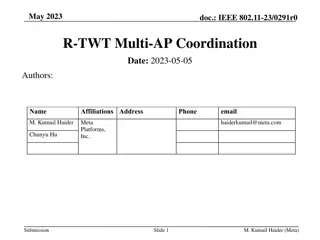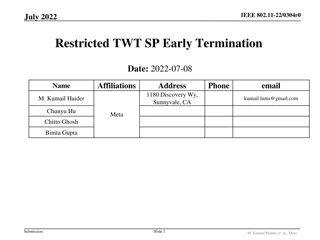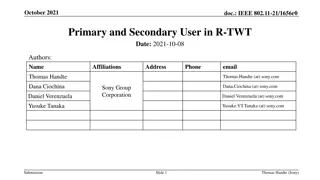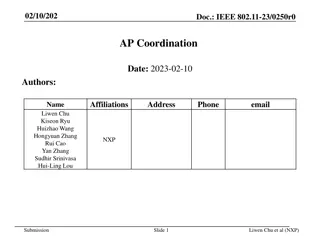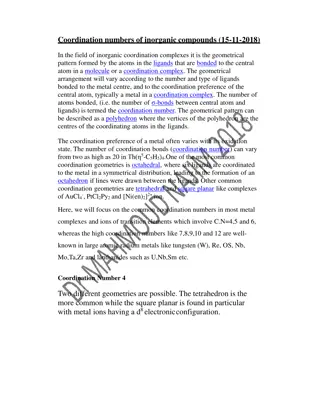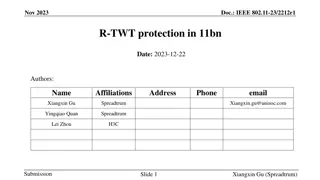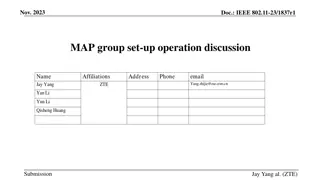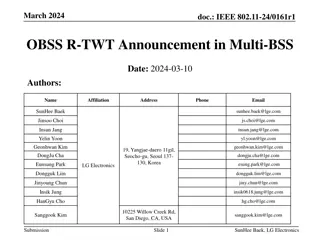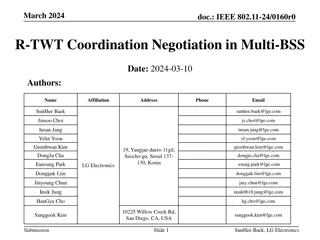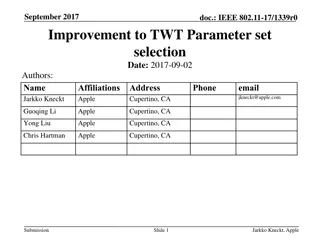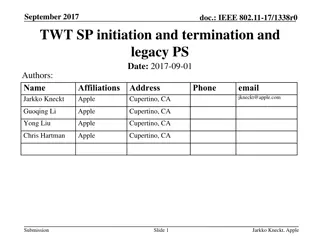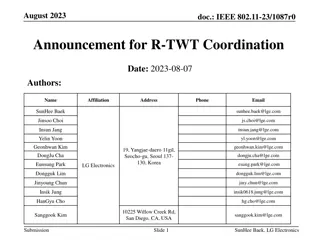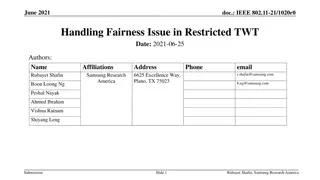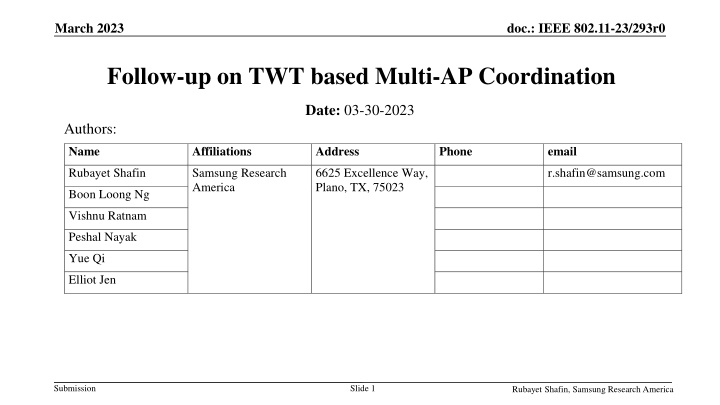
TWT-Based Multi-AP Coordination in IEEE 802.11
Explore the concept of Time-Based Coordination (TWT) for multi-AP setups in IEEE 802.11 networks. Discusses various coordination modes and the need for MAP coordination to manage interference and enhance network performance.
Download Presentation

Please find below an Image/Link to download the presentation.
The content on the website is provided AS IS for your information and personal use only. It may not be sold, licensed, or shared on other websites without obtaining consent from the author. If you encounter any issues during the download, it is possible that the publisher has removed the file from their server.
You are allowed to download the files provided on this website for personal or commercial use, subject to the condition that they are used lawfully. All files are the property of their respective owners.
The content on the website is provided AS IS for your information and personal use only. It may not be sold, licensed, or shared on other websites without obtaining consent from the author.
E N D
Presentation Transcript
March 2023 doc.: IEEE 802.11-23/293r0 Follow-up on TWT based Multi-AP Coordination Date: 03-30-2023 Authors: Name Affiliations Address Phone email Rubayet Shafin Samsung Research America 6625 Excellence Way, Plano, TX, 75023 r.shafin@samsung.com Boon Loong Ng Vishnu Ratnam Peshal Nayak Yue Qi Elliot Jen Submission Slide 1 Rubayet Shafin, Samsung Research America
March 2023 doc.: IEEE 802.11-23/293r0 Abstract In this contribution, we follow up on TWT-based multi-AP coordination for UHR [1]. Submission Slide 2 Rubayet Shafin, Samsung Research America
March 2023 doc.: IEEE 802.11-23/293r0 Motivation Multi-AP Coordination is one of the key features that will be discussed in UHR SG and IEEE 802.11bn [2] Several types of multi-AP coordination have been discussed in both UHR SG and the early phase of 802.11be. Coordinated OFDMA Coordinated Beamforming Coordinated spatial reuse Joint Transmission Coordination among neighboring APs by sharing the clients wake-up pattern info can be beneficial for interference management. The coordinating APs can share TWT information of the STAs in their BSS and thereby provide assistance in either reducing OBSS interference or improving signal power during the TWT SP [1, 3] We refer to such mechanism as coordinated TWT (C-TWT). Submission Slide 3 Rubayet Shafin, Samsung Research America
March 2023 doc.: IEEE 802.11-23/293r0 MAP TWT Coordination Modes There can be different modes of TWT coordination Mode-1: Client-centric assistance TWT coordination can cater to specific STA to reduce its OBSS interference The victim STA can request the coordinating APs to assist in reducing the OBSS interference during its TWT SPs (either individual TWT or broadcast TWT) The request can be made to its associated AP. The associated AP can then share the victim STA s TWT agreement/schedule with the coordinating AP and request to reduce interference towards the victim STA. Alternatively, the request can be made directly to the aggressor AP If the aggressor AP is within the coordinating AP set with associating AP, the aggressor AP can respect the request and reduce interference towards the victim STA. Within the TWT SP of the victim STA, the aggressor AP can use any conventional MAP mechanism, e.g. coordinated beamforming or joint transmission (for SINR boost) Mode-2: Network-wide cooperation TWT coordination can be performed to assist a group of STAs in a BSS An AP can request its neighboring AP to reduce interference during TWT SPs of a B-TWT/R-TWT schedule. During the TWT SPs, the neighboring AP can mute its transmission (C-TDMA) or use a different channel than what the requesting AP is using. Aggressor AP for STA2 AP1 AP2 STA2 Victim STA STA1 STA3 BSS1 BSS2 Association Interference Submission Slide 4 Rubayet Shafin, Samsung Research America
March 2023 doc.: IEEE 802.11-23/293r0 Need for MAP coordination for R-TWT Broadcast TWT IE Restricted TWT is an important tool developed in 11be for low-latency traffic prioritization. The R-TWT supporting STAs in the BSS that are not members of an R-TWT schedule end their TXOP before an R-TWT SP corresponding to the R-TWT schedule starts (in the figure, STA1 ends TXOP before STA2 s R-TWT SP starts) This gives priority to AP (in trigger-based R-TWT) and R- TWT member STAs to win the contention for the R-TWT SPs. t3 t2 Broadcast TWT Beacon R-TWT SP BA AP1 UL PPDU STA1 STA2 (R-TWT scheduled STA) Doze Awake (CCA BUSY) However, the R-TWT supporting STAs in the neighboring BSS may not obey the rules to protect the R-TWT SPs of another BSS Transmission in the neighbor BSS may continue occupying the channel during the R-TWT SPs of the first BSS (in the figure, AP2 doesn t end TXOP before STA2 s R-TWT SP starts) This OBSS interference may disrupt the latency-sensitive traffic of the R-TWT scheduled STAs. DL PPDU AP2 STA3 BlockAck t4 t1 ** Based on the association shown in the figure in the previous slide Submission Slide 5 Rubayet Shafin, Samsung Research America
March 2023 doc.: IEEE 802.11-23/293r0 MAP coordination for R-TWT Coordination among neighboring APs for protecting R-TWT SPs can be beneficial for latency-sensitive applications. The sharing AP can request the shared AP to protect the R-TWT SPs of the sharing AP Types for protection for OBSS R-TWT (in terms of protection-level): Type-1 : The shared AP and all its associated STAs end their TXOP before the sharing AP s R-TWT SP The shared AP and all its associated STAs can t transmit during the R-TWT SP of the sharing AP Type-2 : The shared AP and all its associated STAs end their TXOP before the sharing AP s R-TWT SP starts The shared AP and all its associated STAs can start contending for the channel at the start of the sharing AP s R-TWT SP Type-3: The shared AP ends its TXOP if it is not serving a low latency STA (e.g., serving its own R-TWT scheduled STA) The non-AP STAs in the shared AP s BSS don t end their TXOP if the TXOP has been obtained for low-latency traffic (e.g., R-TWT scheduled STA) Otherwise, the shared AP and all its associated STAs end TXOP before the start of the sharing AP s R-TWT SP After ending the TXOP before the sharing AP s R-TWT SP starts, the shared AP and all its associated STAs can start contending during the R-TWT SP Type-4: Only the shared AP ends its TXOP before the sharing AP s R-TWT SP starts The non-AP STAs in the shared APs BSS don t end their TXOP before the sharing AP s R-TWT SP starts After ending the TXOP before the sharing AP s R-TWT SP starts, the shared AP can start contending during the R-TWT SP * Note: The above rules are for R-TWT supporting STAs-only. ** TWT Sharing AP: The AP that has an R-TWT schedule in its BSS and initiates a TWT coordination request (e.g., AP1 in the previous slide) *** TWT Shared AP: The recipient of the TWT coordination request (e.g., AP2 in the previous slide) Submission Slide 6 Rubayet Shafin, Samsung Research America
March 2023 doc.: IEEE 802.11-23/293r0 Elements of Coordinated TWT The coordinating APs need to share their TWT information (e.g., R-TWT schedule information) to agree on whether to coordinate on TWT or not Negotiation: There can be different types of multi-AP TWT negotiation Implicit MAP TWT agreement: The same MAP coordination cluster can be used for different types of MAP coordination mechanisms. If two APs fall within the same MAP coordination cluster, any mode of coordination is possible within the APs (C-OFDMA, C-SR, C-TWT, etc.). When the sharing AP shares a TWT schedule information with the shared AP in a coordination request, the shared AP will respect the request No further negotiation is needed for specific TWT coordination Explicit MAP TWT negotiation In this mode of negotiation, the sharing AP sends a TWT coordination request to the shared AP (e.g. the request may contain one or more TWT elements) Either using management frames or through backhaul The shared AP will evaluate the request (e.g. checks whether it overlaps with its own R-TWT schedule) The shared AP sends the TWT coordination response frame indicating acceptance, rejection, etc. Agreement to coordinate on another MAP mechanism (e.g. C-OFDMA, C-BF, C-SR) does not imply agreement to coordinate on C-TWT. Announcement: Shared AP s action If the shared AP accepts the TWT coordination request, then it advertises the same R-TWT schedule in its own BSS (MAP TSF synchronization needed) Handling Fairness: There can be separate priority labels tagged with this advertisement (e.g. indicating that this is an OBSS request) Can indicate which channel and bandwidth to use during the RTWT SP Can indicate which SP(s) in the sequence of SPs need to be respected. Submission Slide 7 Rubayet Shafin, Samsung Research America
March 2023 doc.: IEEE 802.11-23/293r0 Summary Multi-AP coordination can be an enabling technology for next-generation WLAN systems In this presentation, we highlight the aspects of TWT-based multi-AP coordination for UHR. Submission Slide 8 Rubayet Shafin, Samsung Research America
March 2023 doc.: IEEE 802.11-23/293r0 References [1] IEEE 802.11-22/1530r1, Multi-AP coordination for next-generation Wi- Fi , Sept 2022. [2] IEEE 802.11-22/932r0, Thoughts on Beyond 802.11be , July 2022. [3] IEEE 802.11-22/1046r3, Multi-AP: TWT Information Sharing , Sept 2021. Submission Slide 9 Rubayet Shafin, Samsung Research America


